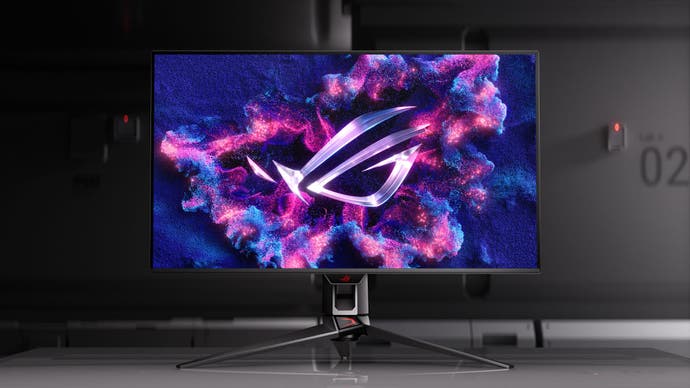The best gaming monitor 2024: Digital Foundry's picks for PC, PS5 and Series X
From budget LCDs to ultra-premium QD-OLED models.
Getting the best gaming monitor can be pretty difficult. This isn't just because there's a lot to consider in terms of the right panel type, resolution and refresh rate for you, but also because some choices are objectively better than others. What's more, a good gaming monitor is a purchase that'll be the centrepiece of your setup for years, so choosing the right one is key - especially if you'll be using it for gaming, work, content consumption and more.
The good news is that 2024 is a particularly good year to upgrade, with impressive QD-OLED and W-OLED models offering the best image quality and (slowly) becoming more affordable, while more traditional LCD-based monitors are getting fancy Mini LED backlights, higher refresh rates and better features at surprisingly low prices.
To keep things easy, we've split our picks by resolution - 1080p, 1440p and 4K. If you're not sure which is right for you, check out our monitor buyer's guide or just start with 1080p. For now, let's get right into the picks!
Best gaming monitor 2024
The best 1080p gaming monitors are easy to drive even with an entry-level gaming PC or last-generation games console, with some also offering the highest refresh rates for competitive gaming. Here are two solid options at different refresh rates:
- Best 1080p 144Hz monitor: LG UltraGear 24GN60R / 24GN650
- Best 1080p 240Hz monitor: Lenovo Legion Y25-30
The best 1440p gaming monitors are right in the sweet spot between price and performance, offering a sharper image than 1080p models plus the option for higher refresh rates at a reasonable premium. Here are several solid choices, including a great QD-OLED ultra-wide:
- Best 1440p monitor: MSI MPG 271QRX QD-OLED
- Best 1440p 240Hz monitor: Philips Evnia 27M2C5500W
- Best ultrawide gaming monitor: Alienware AW3423DW QD-OLED
The best 4K gaming monitors offer incredible visual fidelity, thanks to their higher pixel counts, but can require a powerful graphics card or modern PS5 / Series X console to get the most out of them. Higher refresh rate 4K monitors are more common these days, with 4K 240Hz representing the upper limit and 4K 144Hz being a better value option.
- Best 4K gaming monitor: Dell Alienware AW3225QF QD-OLED
- Best cheap 4K monitor: X= XRGB27UHD
Finally, we've also looked at a handful of portable monitors, for use on the go or with the likes of the Switch or Steam Deck.
- Best portable gaming monitor: Arzopa G1 Game
Best 1080p gaming monitors
The vast majority of PC gamers, 58 percent, play at a resolution of 1920x1080 - with only 19 percent at 1440p and only four percent at 4K. The reasons are straightforward: 1080p monitors are affordable, easy to drive with a modestly powerful PC and offer the very highest refresh rates for competitive play. Our selections begin with an affordable 144Hz option, which you ought to consider the baseline spec for a gaming monitor, then fancier models with better features and faster refresh rates.
Best 1080p 144Hz monitor: LG UltraGear 24GN60R / 24GN650
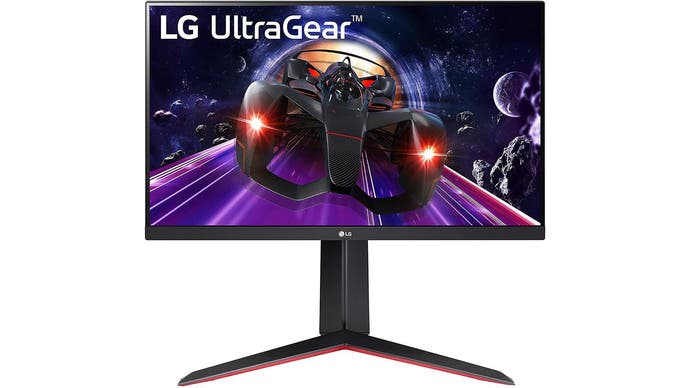
For fast-paced multiplayer games, high refresh rate monitors make it easier to track moving targets and hit those headshots. 144Hz is the base standard here, and the best 1080p monitor at this spec is the £130/$170 LG UltraGear 24GN60R or similar 24GN650. These models are built around one of LG's own Fast IPS displays, and therefore offers better colour accuracy and wider viewing angles than more common TN or VA alternatives while also delivering fast (1ms GtG) response times, making them an incredible choice for both fast-paced games and more sedate titles alike.
The downsides of an IPS display manifest in relatively low brightness (250 nits) and only moderate contrast (1000:1). Still, for mixed use that includes web browsing, content creation and gaming, it's hard to argue against Fast IPS as the best mix of features, especially as these panels have become more affordable. Ergonomics are a strong suit too, with options for tilt, swivel, rotation and height adjustment. These models are also G-Sync/Free-Sync compatible, helping to smooth out uneven frame-rates and reduce judder. Overall, a great option for this spec.
Best 1080p 240Hz monitor: Lenovo Legion Y25-30
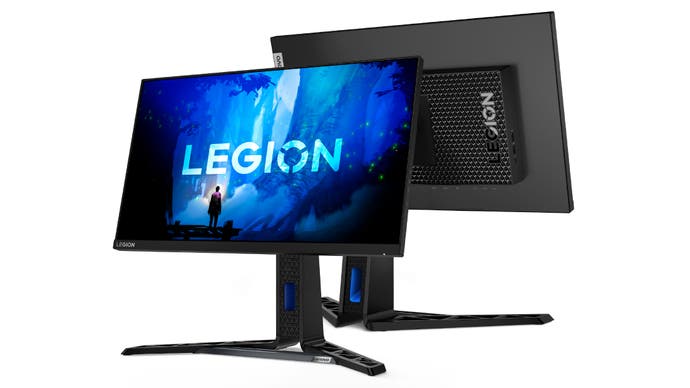
The £179/$185 Lenovo Legion Y25-30 offers a 280Hz overclock, rated 0.5ms MPRT response time and built-in speakers all for not much more than a good 144Hz monitor, making it a tempting upgrade option for competitively-minded gamers that can take advantage of its high refresh rate. You're not quite approaching OLED levels of motion clarity, but you're also paying a heck of a lot less.
The Fast IPS panel used here does still offer wide viewing angles and good colour accuracy, making this a decent choice for watching videos, surfing the web or getting work done - though higher resolutions are a better shout for content creators. For example, it's possible to get sharper 1440p 240Hz options that are better all-rounders, so you ought to look at budget 1440p 240Hz alternatives too.
I also dig the design here, which feels quite different to most other gaming or office monitors on the market and sets itself apart without resorting to strong RGB lighting or other ornamentation.
Best 1440p gaming monitors
If you're looking for a sharper screen that provides more detail at a comfortable distance, then a 1440p screen is a great shout. The higher resolution panel means you won't need to look at a grainy image, but it does require more horsepower to drive.
Best 1440p monitor: MSI MPG 271QRX QD-OLED

The £898 MSI MPG 271QRX is the best 1440p monitor we've ever tested, and perhaps the best monitor of any category for FPS gaming. This is down to the extremely high performance QD-OLED panel used, which provides unparalleled motion clarity at refresh rates up to 360Hz with staggeringly low pixel response times and input lag. This is an absolute godsend for competitive gaming, where tracking targets and flicking onto opponents has never been easier.
Unlike other speciality high refresh rate esports monitors based on LCD technology, the MPG 271QRX doesn't sacrifice everyday usability either. The QD-OLED panel also delivers impactful HDR, gorgeous colours, perfect contrast and wide viewing angles for videos and gaming, while the 1440p resolution at 27 inches delivers sharp text rendering for work and web surfing. The third-gen Samsung QD-OLED panel used here comes with improvements to its sub-pixel structure, eliminating the text fringing issues that held previous generations back.
The MSI monitor also benefits from a KVM switch, USB-C power delivery up to 90W and near-perfect coverage of the most commonly used colour spaces (including sRGB and DCI P3) with promised Delta-E colour accuracy values under 2.0. In our testing, we found that the MPG 271QRX did even better, with average Delta-E values of 0.99 - errors indistinguishable to the human eye. MSI also offers the best range of burn-in prevention controls, with individual options for multi-logo detection, taskbar detection and boundary detection, backed with a three-year burn-in warranty.
While nearly £900 is a lot for a 27-inch monitor, it's hard to argue with the overall quality of the MPG 271QRX. It's a premier monitor for esports and indeed all PC gaming, while at the same time being a powerful option for productivity work and content consumption. For that reason, it gets our top overall recommendation in the 1440p category.
Note that the MPG 271QRX can be hard to find in some regions, so consider the nearly-identical £749/$720 MAG 271QPX. This model uses the same excellent QD-OLED panel but lacks RGB, firmware upgradability and KVM functionality. It also has a much lower USB-C charging speed (15W vs 90W). Regardless, given the discount, it's a good cheaper alternative for most people.
Best 1440p 240Hz monitor: Philips Evnia 27M2C5500W
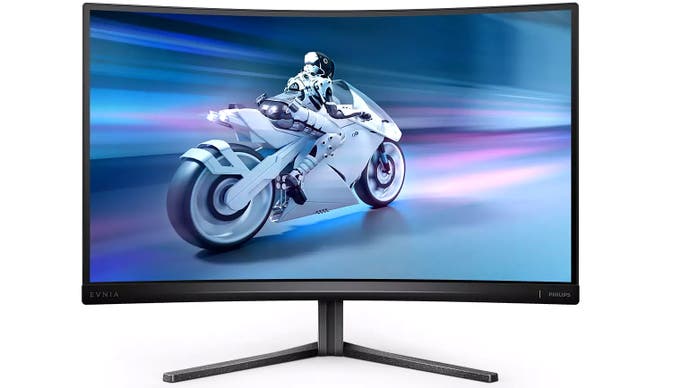
The £275 Philips Evnia 27M2C5500W marries a 2560x1440 resolution with a high 240Hz refresh rate, allowing this 27-inch curved monitor to shine in a wide range of games, from fast-paced shooters to leisurely turn-based strategy games. This particular model uses a VA screen, which offers good motion clarity with a quoted 0.5ms MPRT pixel response time plus great colour reproduction, wide viewing angles and exceptional contrast.
The monitor's aesthetics are top-notch, with a pleasant geometric design on the curved back, four USB ports hidden on the underside of the monitor and an otherwise clean, modern design elsewhere. Height, tilt and swivel adjustment is possible, and a 100x100 VESA mount provides more mounting options - although the (admittedly very budget) arm I had spare was a few millimetres too large to fit the strictly-defined VESA cutout. The OSD is also comprehensive, with a wide range of game modes and features available, to the point of excess - it was sometimes difficult to know what settings I had to change to unlock other options.
In our testing, we found this monitor offered a noticeable competitive advantage over more ordinary 144Hz and 165Hz monitors, while offering a much sharper picture than 1080p 240Hz options. The low price of the Philips Evnia 27M2C5500W and its relatively strong performance overall make it our new top recommendation for this category.
Best ultrawide gaming monitor: Alienware AW3423DW QD-OLED
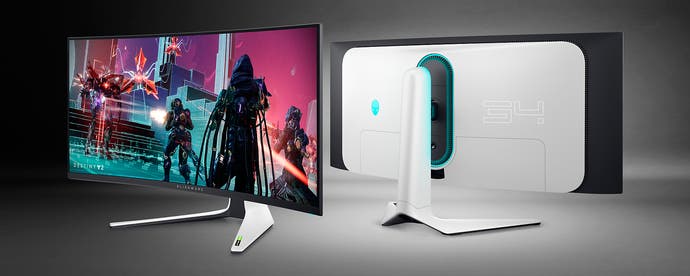
The £740/$900 Dell Alienware AW3423DW is the best 1440p ultrawide we've ever tested, thanks to its Samsung QD-OLED panel. This screen offers infinite contrast with perfectly inky blacks, a wide colour gamut, instant pixel response times and and reasonable brightness. The 3440x1440 175Hz spec is great for PC use, whether gaming or content creation, but doesn't suit consoles as there's no way to downscale from 4K - and consoles don't support ultra-wide resolutions.
The motion handling is superb, making this a great monitor for fast-moving games like shooters or racing titles, while the curved 34-inch screen is suitably immersive. Playing games like Metro Exodus, where you're exploring the desert at night, you can really appreciate the contrast available here. The monitor still gets bright enough to be used in the day, but brighter IPS or VA monitors could be a better fit for truly bright rooms. It performs best at night or in darker rooms, where its contrast reaches its lowest levels and you can really enjoy gaming or watching films.
After several weeks of testing, I have to offer a strong recommendation for this monitor, but I should also mention two further quirks of the unique screen tech:the screen could suffer from burn-in, although there are plenty of countermeasures and user habits to prevent this, and the text is not as crisp as most other displays due to a different subpixel structure - something fixed on later generations like our current 4K 240Hz pick. Neither of these issues bothered me during testing, but if you're particularly worried then you should do your own research to arrive at a conclusion.
Best 4K gaming monitors
With the PS5 and Xbox Series X, 4K gaming has become the default resolution for millions of gamers - while on the PC side, the advent of upscaling and frame generation solutions such as DLSS, FSR and XeSS means that 4K displays are easier to drive than ever before. Here are our picks for the best 4K monitors for gaming, starting with the best monitors you can get, 4K 240Hz, as well as more affordable 4K 144Hz options.
Best 4K gaming monitor: Dell Alienware AW3225QF

The £989/$1200 Dell Alienware AW3225QF is one of the best monitors we've ever tested, thanks to its third-generation 32-inch Samsung QD-OLED panel - and it's also the cheapest monitor to use this panel by some margin in the UK, earning it our top recommendation overall.
This monitor is hugely impressive in person, delivering impactful HDR with bright 1000 nit highlights, gorgeous colour reproduction, wide viewing angles, perfect blacks and Dolby Vision support for games and video. It's not a one-trick pony either, with even fast-paced esports games like Counter-Strike 2 and F1 23 benefitting from the high 240Hz refresh rate and extremely fast pixel response times inherent to OLED panels. There's also HDMI 2.1 support for playing PlayStation or Xbox consoles at up to 4K 120Hz in HDR, so you really can do it all.
The third-gen QD-OLED panel also shores up the category's traditional weaknesses with more robust burn-in protection (including an improved heatsink, more burn-in countermeasures and a three-year warranty that covers burn-in) and an improved subpixel arrangement that leads to sharper text with less colour fringing than on earlier generations. That makes the AW3225QF a much better choice for general computer use, such as content creation or web browsing.
One thing to keep in mind is that QD-OLED monitors like these don't get quite as bright as similarly high-end LCD-based monitors, and blacks can look a bit purple or grey in extremely bright environments. This wasn't an issue for me even on the brightest spring days in the UK, but it's something to consider if you're unable to moderate your room's light intensity.
The AW3225QF is a decidedly premium proposition at nearly £1000, but its QD-OLED panel is also a significant step forward over any other we've tested, with unmatched image quality and performance. For the lucky few that can justify the expense, this is an incredible monitor that we can't recommend highly enough.
Alienware AW3225QF alternatives: MSI MPG 321URX + Asus ROG PG32UCDM

Two other monitors are available that use the same Samsung QD-OLED panel and therefore offer near-identical performance: the MSI MPG 321URX and Asus ROG Swift PG32UCDM. In terms of features, the Dell is curved and has Dolby Vision support, while the other two are flat with no Dolby Vision support (yet), but more comprehensive burn-in controls and up to 90W USB-C charging and KVM functionality.
At the time of writing, the £989 Dell model is significantly cheaper in the UK than the £1349 Asus and the £1299 MSI. However, in the US this is reversed, with the MSI being the cheapest option by a similar margin ($950) and the Dell ($1200) and Asus ($1300) variants carrying more of a premium. For most people, I would recommend the cheapest option in your region, as the panel delivers much the same performance and features on all three varieties, though those particularly interested in burn-in mitigation controls or need that USB-C functionality might opt for the MSI or Asus options even if they come at a higher price.
Best cheap 4K 144Hz monitor: X= XRGB27UHD

The £389 X= XRGB27UHD is one of the cheapest 4K 144Hz monitors available, with HDMI 2.1 support for connecting to consoles like the Xbox Series X and PS5 - plus PCs with current-gen graphics cards. A DisplayHDR 600 certification means that the monitor gets bright enough to deliver impactful HDR, and the Fast IPS panel's reasonable response time and good DCI-P3 gamut coverage means that the monitor is a strong all-rounder - you could use it quite happily for editing photos one minute and ripping through demons in Doom Eternal the next. The screen's also FreeSync and G-Sync Compatible, so you get variable refresh rate support on both AMD and Nvidia-based PCs. Finally, the monitor includes KVM functionality, meaning you can use one keyboard and mouse plugged into the monitor with multiple PCs - pretty neat!
While the screen and features are impressive, the low price does manifest in a few areas. The included stand is quite basic, lacking height adjustment, and it proved difficult to mount properly on our review unit. Thankfully, a standard 100x100 VESA mount means that it's easy to mount on an arm. There's RGB backlighting on the rear, which can be disabled if you wish - but a powerful status LED that fires down from the right bottom side of the monitor can only be covered by electrical tape. The OSD is also very basic. Finally, the built-in speakers don't sound great, but they are at least handy if you don't have a headset or separate speakers nearby.
Overall, it's not a completely perfect package, but you do get some noticeable improvements over first generation 4K 144Hz panels while paying less money - so if you're on a budget and want to live that 4K 144Hz life, this monitor is a savvy choice.
In the US? Consider the Dough Spectrum One (originally known as the Eve Spectrum). This monitor offers a beautiful design, LG Fast IPS panel and excellent 4K 144Hz performance with a DisplayHDR 600 rating. HDMI 2.1 means that this monitor suits PS5 and Series X too. The monitor comes with a choice of matte or glossy screens, which offer better reflection handling or better colour reproduction respectively. The glossy model is more expensive - $500 without a stand or $600 with - but is more readily available than the cheaper matte variant, which is out of stock at the time of writing. Dough's shipping and customer support are far from the best in the industry, but it's now possible to get the monitor from B&H Photo Video for a much more reliable shopping experience.
Best portable gaming monitor: Arzopa G1 Game

The best portable gaming display we've tested is the £119/$150 Arzopa G1 Game, a 15.6-inch super-slim monitor that runs at 1080p 144Hz. This increase in fluidity over a standard 60Hz display is ideal for competitive FPS or racing titles, and works well with the Steam Deck as the 1080p resolution as possible to attain with some sacrifices to image quality. This also works well for PC and PS5 use, although many mid-range PCs and the PS5 certainly benefit from a higher-resolution screen. Viewing angles and colour reproduction were reasonable thanks to the IPS panel, with the screen's limited brightness and a bit of a high-pitched hum being the only major strike against it. Still, for the asking price, this is a solid option.
If you'd prefer a 4K display, the $399 Desklab 4K USB-C monitor supports 4K 60Hz gaming on next-gen and last-gen consoles via HDMI, and PC/mobile gaming via HDMI or USB-C. The latter is the superior connection method, normally requiring only a single cable to power the monitor and send video data, but some machines don't support DisplayPort over USB-C - including my Pixel 6 phone and a desktop PC built around an Aorus X570 motherboard. On the other hand, I had good results with an Intel-based Dell laptop, the Xbox Series X and the PlayStation 5. Pixel response times and contrast were reasonable, with a usable up to 400 nits of brightness. Colours and viewing angles were up to snuff too, as you'd hope from an IPS panel, and even HDR is technically supported.
How to choose the best gaming monitor
Choosing the best gaming monitor is a simple process that starts with working out what sorts of games or other applications you plan to run.
Generally, fast-paced and competitive games like shooters, real-time strategy or racing games will benefit from higher refresh rate monitors, while slower-paced games like role-playing games and turn-based strategy games are best played on a higher-resolution monitor.
Resolution is normally given as the number of horizontal pixels (eg 1080p, 1440p), while refresh rates are given in Hz and correspond to how many times per second the screen is redrawn (eg 60Hz, 144Hz). For example, the standard specification for entry-level monitors is 1080p 60Hz (a 1920 pixel wide and 1080 pixel tall screen that updates 60 times per second). Meanwhile, the current gaming monitor sweet spot between price and performance is 1440p 144Hz (a 2560x1440 screen that updates 144 times a second). To learn more, read our guide to essential monitor terms here.
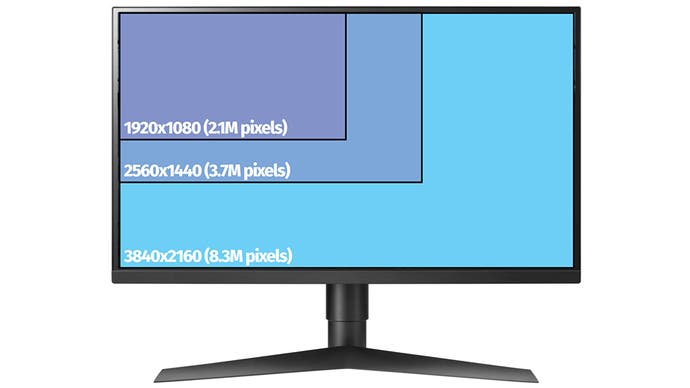
In broad strokes, an entry-level PC will be best used with a 1080p 60Hz monitor, while a mid-range PC can stretch to a higher resolution (1440p), a higher refresh rate (144Hz) or both. Finally, high-end PCs are a good fit for 4K. Bear in mind that the real situation is more complicated than this, as some games are more demanding to run than others and it's often possible to turn down graphical fidelity settings in exchange for a higher frame-rate.
The current sweet spot between price and performance are monitors with a 1440p resolution and 144Hz refresh rate. In slower paced games and content creation, you'll appreciate the extra visual fidelity and screen real estate, while in faster esports titles the higher refresh rate will make hitting flicks or skill shots easier. That's why we've selected a monitor that fits this specification as the best gaming monitor overall. Of course, there are plenty of alternatives too!
For consoles, things are a little simpler. HDMI 2.1 monitors support 4K resolution up to 120Hz, matching the highest possible output of the Xbox Series X and PS5, and are finally available at reasonable prices. If you're operating on a more limited budget, then a 4K 60Hz monitor (for slower games) or 1080p 120Hz monitor (for competitive games) are good bets too.
Arms are the ultimate gaming monitor upgrade
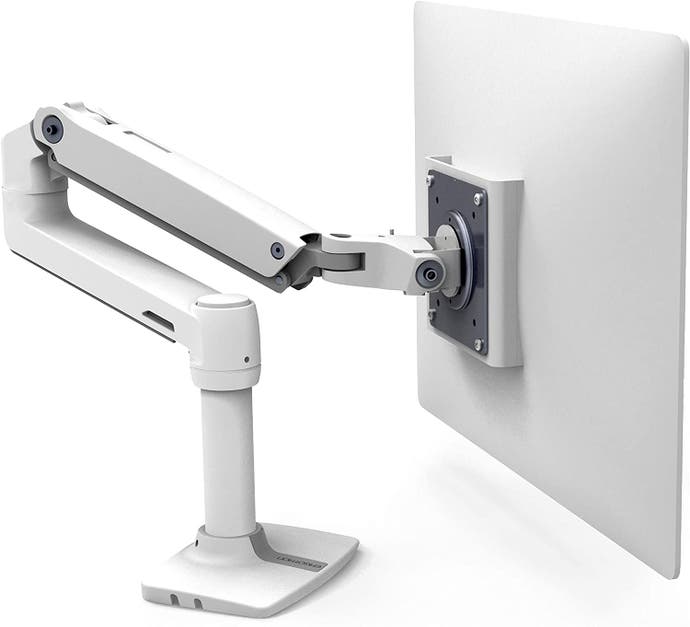
Many gaming monitors don't come with brilliant stands - they might lack height adjustment, they might be a little unstable, or they're simply ugly. My preferred method of dealing with this is to use a monitor arm whenever possible, which allows me to position the monitor much more easily and also ensures that my entire desk space can be dedicated to mouse, keyboard and cups of tea. This prevents me from running my mouse into the base of the monitor stand accidentally, and means I can adopt a much more natural and comfortable posture with the mouse and keyboard in line with my arms rather than being stretched to either side.
There are plenty of nice monitor stands out there, but here at Digital Foundry we tend to use Ergotron monitor arms. My colleague John Linneman uses an Ergotron HX arm for his ultra-wide, while I use a similarly robust Ergotron LX arm for two of my three 16:9 monitors (the other is held by the nice but overpriced Herman Miller Ollin monitor arm). If your budget can't quite stretch to Ergotron, then Amazon Basics models are a reasonable replacement at a lower price.
Essential terms for monitor buyers
Picking up your first monitor? Here are some common specs and what they actually mean.
Resolution: How many pixels are on screen, given as horizontal x vertical. 1920x1080 (1080p) and 3840x2160 (4K) are the most common resolutions for both TVs and monitors. The higher the resolution, the crisper and more detailed a game tends to look.
Refresh rate: How many times the screen updates per second, given in Hz. Standard monitors and TVs refresh at 60Hz, while gaming models may refresh anywhere from 100 to 240Hz, with 144Hz being the most common choice for a high refresh rate monitor. The higher the refresh rate, the more fluid a game will feel.
Response time: This stat typically measures how fast a pixel can turn from grey to white and then back to grey again. Most gaming monitors sport response time figures of less than 5ms, with TN panels being the fastest and IPS or VA screens being a little slower. Low response times help to eliminate distracting smears in fast-paced scenes. Note that response time is distinct from input lag, which refers to the delay between an input (like pressing a button) and seeing the effect of the input on-screen.
Contrast ratio: Simply the ratio between the brightness of a display when it is displaying perfect black versus perfect white. Around 1000:1 is typical for an IPS display, a VA display can hit 3000:1 or higher and an OLED has technically infinite contrast, as its organic LEDs can switch off entirely to create a completely dark image. High contrast ratio screens look particularly good in dark rooms, as blacks will appear properly black rather than dark grey. When a high contrast display also has high peak brightness levels (eg 600 nits and up), HDR content will look punchier too.
G-Sync/FreeSync: These are both terms that refer to adaptive sync technology, designed to eliminate ugly screen-tearing while adding less input lag than traditional v-sync. G-Sync is Nvidia's implementation, which technically requires a physical G-Sync module inside the monitor that can drive up prices. FreeSync is the AMD alternative, which doesn't require a special module and therefore doesn't add much to a monitor's price. However, nowadays few monitors bother with a physical module, and we often see displays that are technically 'G-Sync Compatible' being just listed as 'G-Sync'. In general, you don't need to worry so much these days about finding a monitor that suits your graphics card; basically any monitor that supports VRR will work on any modern GPU from AMD, Intel or Nvidia.
HDR: High Dynamic Range allows for greater contrast between the lightest and darkest parts of an image, as well as a wider colour gamut. While a growing number of monitors are technically HDR-capable, most can't hit the high peak brightness figures that actually make the feature worthwhile. We recommend sticking with monitors that hit stringent standards, like DisplayHDR 600 or DisplayHDR True Black 400, if playing games or watching films in HDR is important to you.
IPS: This sort of monitors tend to be expensive to produce, but provide better viewing angles and improved colour accuracy compared to monitors using VA or TN panels. However, some IPS panels, particularly older ones, can suffer from slower response times, making them worse for fast-paced games. Another potential issue is 'IPS glow', where the monitor's backlight is visible in dark scenes. Fast IPS monitors tend to offer the best of both worlds, with TN-like motion handling and IPS-like viewing angles, colours and contrast.
TN: The most mature display technology, TN panels are cheap to produce and offer some of the fastest response times. However, colour accuracy and viewing angles tend to be poor, sometimes resulting in a washed out look - particularly if you're not viewing the monitor head-on. However, modern TN panels do well to minimise these drawbacks.
VA: A type of monitor panel which tends to occupy a middle-ground between IPS and TN in many respects. These panels generally offer the best contrast, backed with good response times and colour reproduction.
OLED: Available in both QD-OLED and W-OLED varieties, OLED screens are a premium option with huge advantages as well as some pitfalls. The advantages are numerous and impactful, including gorgeous colour reproduction, wide viewing angles and near-instant pixel response times. Perhaps most importantly, having self-emissive pixels rather than relying on a backlight means that pixels can turn off completely for perfect blacks and don't exhibit the haloing seen on LCD-based screens. However, OLED screens are at greater risk of permanent image retention (aka burn-in) and require countermeasures to prevent this, such as dimming static content like logos or the Windows taskbar. OLED screens also don't get as bright as many LCD alternatives, making them less suitable for extremely bright environments. Still, on the whole this is a fantastic panel choice if your budget allows.
QD-OLED vs W-OLED: QD-OLED screens are typically made by Samsung and come with a Quantum Dot layer that results in better and more vibrant colour reproduction than rival W-OLED screens made by LG, particularly for green and red tones. However, W-OLED screens tend to offer a slightly better subpixel arrangement for fine elements like small text and boast brighter whites, making them brighter in a typical desktop environment. Both are strong options, no doubt, but based on our testing thus far QD-OLED is the more exciting option for PC gamers.
